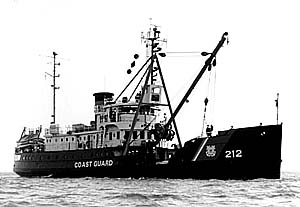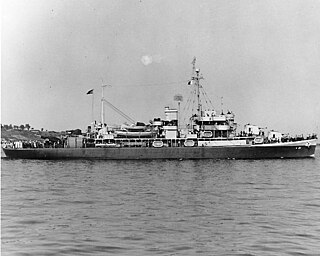Three vessels of the United States Navy or United States Coast Guard have been named USS Onondaga, after Onondaga Lake and Onondaga County, New York.

USCGC Sundew (WLB-404) is a 180-foot (55 m) sea going buoy tender (WLB). An Iris, or C-class tender, it was built by Marine Iron and Shipbuilding Corporation in Duluth, Minnesota, United States. Sundew's preliminary design was completed by the United States Lighthouse Service and the final design was produced by Marine Iron and Shipbuilding Corporation in Duluth for the U.S. Coast Guard. On 29 November 1943 the keel was laid. It was launched on 8 February 1944 and commissioned on 24 August 1944. The original cost for the hull and machinery was $861,589.
USCGC Alder can refer to the following ships of the United States Coast Guard:
USS Mayflower has been the name of more than one United States Navy ship:

USS Mayflower (PY-1) was the second ship in the United States Navy to have that name. Mayflower was a luxurious steam yacht built in 1896, by J. and G. Thompson, Clydebank, Scotland for millionaire Ogden Goelet, who died on board Mayflower, in August 1897. Her sister ship, said to be almost identical and built at the same time and in the same yard for brother, Robert Goelet, later became USS Nahma.
USCGC Spar (WLB-403) was a 180-foot (55 m) sea going buoy tender. An Iris class vessel, she was built by Marine Ironworks and Shipbuilding Corporation in Duluth, Minnesota. Spar's preliminary design was completed by the United States Lighthouse Service and the final design was produced by Marine Iron and Shipbuilding. On 13 September 1943 the keel was laid, she was launched on 2 November 1943 and commissioned on 12 June 1944. The original cost for the hull and machinery was $865,941.

USS Biscayne (AVP-11), later AGC-18, was a United States Navy Barnegat-class seaplane tender in commission as a seaplane tender from 1941 to 1943 and as an amphibious force flagship from 1943 to 1946. She saw service during World War II. Transferred to the United States Coast Guard after the war, she was in commission as the Coast Guard cutter USCGC Dexter (WAGC-385), later WAVP-385 and WHEC-385, from 1946 to 1952 and from 1958 to 1968.

USS Coos Bay (AVP-25) was a United States Navy Barnegat-class small seaplane tender in commission from 1943 to 1946 that saw service during the latter half of World War II. After the war, she was in commission in the United States Coast Guard from 1949 to 1966 as the cutter USCGC Coos Bay (WAVP-376), later WHEC-376.

The United States Coast Guard Cutter Fir was the last lighthouse tender built specifically for the United States Lighthouse Service to resupply lighthouses and lightships, and to service buoys. Fir was built by the Moore Drydock Company in Oakland, California in 1939. On 22 March 1939, the U.S. Lighthouse Tender Fir was launched. She was steam driven with twin screws, 175 feet (53 m) in length, had a beam of 32 feet (9.8 m), drew 11 feet 3 inches (3.43 m) of water, and displaced 885 tons. Fir was fitted with a reinforced bow and stern, and an ice-belt at her water-line for icebreaking. She was built with classic lines and her spaces were lavishly appointed with mahogany, teak, and brass. The crew did intricate ropework throughout the ship. The cost to build Fir was approximately US$390,000. Fir's homeport was Seattle, Washington for all but one of her fifty one years of service when she was temporarily assigned to Long Beach, California when USCGC Walnut was decommissioned on 1 July 1982.

The second USS Suwannee and third USS Mayflower was a United States Lighthouse Board, and later United States Lighthouse Service, lighthouse tender transferred to the United States Navy in 1898 for service as an auxiliary cruiser during the Spanish–American War and from 1917 to 1919 for service as a patrol vessel during World War I. She also served the Lighthouse Board and in the Lighthouse Service as USLHT Mayflower from 1897 to 1898, from 1898 to 1917, and from 1919 to 1939, and in the United States Coast Guard as the first USCGC Mayflower (WAGL-236) in 1939 and from 1940 to 1943 and as USCGC Hydrangea (WAGL-236) from 1943 to 1945.
Two vessels of the United States Coast Guard have borne the name USCGC Greenbrier:

USS Humboldt (AVP-21) was a United States Navy Barnegat-class small seaplane tender in commission from 1941 to 1947 that served in the Atlantic during World War II. She was briefly reclassified as a miscellaneous auxiliary and redesignated AG-121 during 1945. After the war, she was in commission in the United States Coast Guard as the cutter USCGC Humboldt (WAVP-372), later WHEC-372, from 1949 to 1969,
USCGC Tampa has been the name of four cutters of the United States Revenue Cutter Service and United States Coast Guard:
USCGC Mackinac has been the name of more than one United States Revenue Cutter Service and United States Coast Guard ship, and may refer to:

Lieutenant Junior Grade Clarence Samuels, was the first Hispanic American of African descent photographer in the United States Coast Guard, to command a cutter, as well as the first one to be a commanding officer of a Coast Guard vessel during wartime.

USLHT Mangrove was a lighthouse tender in commission in the fleet of the United States Lighthouse Board from December 1897 to April 1898 and from August 1898 to 1910, in the United States Lighthouse Service from 1910 to 1917 and from 1919 to 1939, and in the United States Coast Guard from 1939 to 1941 and in 1946. She also saw commissioned service in the United States Navy as USS Mangrove on three occasions, operating as an armed supply ship from April to August 1898 during the Spanish–American War, during which she fought the last battle of that war; as a patrol vessel from 1917 to 1919 during and in the aftermath of World War I; and as a buoy tender from 1941 to 1946 during and in the aftermath of World War II.

USLHT Camellia was a lighthouse tender in commission in the fleet of the United States Lighthouse Service from 1911 to 1917 and from 1919 to 1939, and – as USCGC Camellia (WAGL-206) – in the fleet of the United States Coast Guard from 1939 to 1947. During World War I she briefly saw war service with the United States Army in 1917 before serving as the United States Navy patrol vessel USS Camellia from 1917 to 1919. She also saw service in World War II under U.S. Navy control while in the Coast Guard fleet. After the conclusion of her United States Government career, she operated for decades in the service of the Dominican Navy as Capotillo.
USCGC Hemlock (WAGL-217) was a lighthouse tender in commission in the fleet of the United States Lighthouse Service as USLHT Hemlock from 1934 to 1939, and in the fleet of the United States Coast Guard as USCGC Hemlock from 1939 to 1958. During World War II, she was given the additional designation (WAGL-217).
USCGC Acacia can refer to the following ships of the United States Coast Guard:
This page is based on this
Wikipedia article Text is available under the
CC BY-SA 4.0 license; additional terms may apply.
Images, videos and audio are available under their respective licenses.









